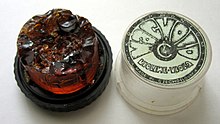Our website is made possible by displaying online advertisements to our visitors.
Please consider supporting us by disabling your ad blocker.
Rosin

Rosin (/ˈrɒzɪn/), also called colophony or Greek pitch (Latin: pix graeca), is a solid form of resin obtained from pines and some other plants, mostly conifers, produced by heating fresh liquid resin to vaporize the volatile liquid terpene components. It is semi-transparent and varies in color from yellow to black. At room temperature rosin is brittle, but it melts at stove-top temperature. It chiefly consists of various resin acids, especially abietic acid.[1] The term colophony comes from colophonia resina, Latin for "resin from Colophon" (Ancient Greek: Κολοφωνία ῥητίνη, romanized: Kolophōnía rhētínē),[2][3] an ancient Ionic city.[4] It is an FDA approved food additive.[5]
- ^ Fiebach, Klemens; Grimm, Dieter (2000). "Resins, Natural". Ullmann's Encyclopedia of Industrial Chemistry. doi:10.1002/14356007.a23_073. ISBN 978-3-527-30673-2.
- ^ Colophon. Charlton T. Lewis and Charles Short. A Latin Dictionary on Perseus Project.
- ^ Κολοφώνιος. Liddell, Henry George; Scott, Robert; A Greek–English Lexicon at the Perseus Project.
- ^ "colophony". Oxford English Dictionary (Online ed.). Oxford University Press. (Subscription or participating institution membership required.) "ad. L. colophōnia (Pliny) for Colophōnia rēsīna resin of Colophon".
- ^ Nutrition, Center for Food Safety and Applied (2022-08-25). "Food Additive Status List". FDA.
Previous Page Next Page


